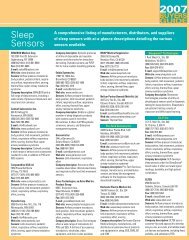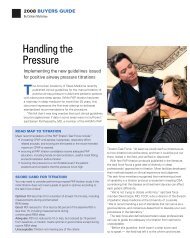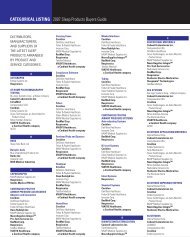View Full Screen - ADVANCE for Respiratory Care and Sleep ...
View Full Screen - ADVANCE for Respiratory Care and Sleep ...
View Full Screen - ADVANCE for Respiratory Care and Sleep ...
Create successful ePaper yourself
Turn your PDF publications into a flip-book with our unique Google optimized e-Paper software.
n CHRONIC OBSTRUCTIVE PULMONARY DISEASE<br />
to correct perceptions <strong>and</strong> help blacks seek<br />
appropriate treatment earlier.”<br />
Shifting Susceptibility<br />
COPD is no longer a ‘white man’s problem’<br />
By Valerie Neff Newitt<br />
White meN once had the dubious<br />
distinction of “owning” chronic<br />
obstructive pulmonary disease. Not<br />
any more. COPD has widened its grip, constricting<br />
airways of blacks <strong>and</strong> females as they<br />
embrace smoking with the same fervor as did<br />
white males half a century ago.<br />
The public misperception that COPD primarily<br />
strikes caucasian men has only added to the<br />
problem. Pulmonologist Jermaine Jackson, MD,<br />
sees a diverse patient population in his practice<br />
at Georgia Lung Associates, Austell, Ga. “What<br />
I observe is this: African Americans with COPD<br />
are younger <strong>and</strong> have more severe disease than<br />
white counterparts.”<br />
And while his patients may realize smoking<br />
causes heart <strong>and</strong> lung problems, “… they think<br />
they are immune to COPD. I hear, ‘I didn’t think<br />
that was applicable to me. This is not an African<br />
American problem; it’s a white man’s problem. I<br />
just thought I was getting older,’” Dr. Jackson<br />
said. “By the time an African American patient<br />
gets to me, in early to mid-50s, he is already in<br />
severe COPD. We in health care are challenged<br />
COPD RESOURCES<br />
Our COPD spotlight offers targeted articles, relevant jobs, columns,<br />
blogs <strong>and</strong> other helpful in<strong>for</strong>mation. Visit http://respiratory-caresleep-medicine.advanceweb.com/COPD/default.aspx.<br />
The leap to statistical data<br />
That anecdotal snapshot on the COPD ethnic/<br />
gender chasm is backed up by hard data, subject<br />
to interpretation.<br />
“If we look at the incidence of COPD <strong>and</strong><br />
mortality rates over the last century, they track<br />
according to when different demographics actually<br />
started smoking,” said Mark Dransfield,<br />
MD, of Birmingham, Ala., who spoke May 16<br />
be<strong>for</strong>e the American Thoracic Society 2011<br />
International Conference in Denver on the topic<br />
of “Racial Disparities in COPD.”<br />
In the 1900s, the first group to start smoking<br />
heavily was white men. Next, white women<br />
started smoking in numbers, followed by black<br />
men, then black women. The effects on disease<br />
frequency <strong>and</strong> death, Dransfield said, become<br />
evident 30 to 50 years later.<br />
But on top of increased smoking habits, is<br />
there a superimposed increased susceptibility <strong>for</strong><br />
COPD among women <strong>and</strong> African Americans,<br />
causing their current statistical numbers to catch<br />
up with those of white males<br />
“It depends on what study you look at,”<br />
Dr. Dransfield said. “Some suggest there could<br />
be differences in nicotine metabolism — that<br />
it’s easier <strong>for</strong> African Americans to become<br />
addicted to cigarettes. But we don’t know yet<br />
if that’s definitively true.”<br />
There is also a persistent hypothesis suggesting<br />
a female’s airway caliber is narrower than<br />
a male’s, thus a similar injury from smoking<br />
would result in more airway obstruction <strong>for</strong><br />
women than men. Again, this idea is likely to<br />
be true, but not yet proven.<br />
“If you look at cross-sectional studies, you<br />
find at the same level of lung function impairment,<br />
women <strong>and</strong> African Americans have<br />
smoked less <strong>and</strong> tend to be younger,”<br />
Dr. Dransfield said. “At 60 percent of lung<br />
function left, the average woman would be<br />
several years younger than the average man with<br />
the same level of lung function.”<br />
He also pointed to studies that appear to show<br />
differences between races in the distribution of<br />
the emphysema that they get. “Looking at people<br />
with very advanced COPD who were being<br />
evaluated <strong>for</strong> lung transplant, we’ve seen that<br />
African Americans have less emphysema <strong>and</strong> the<br />
pattern is different than that seen in whites. So<br />
it looks like the biological response to smoke<br />
jeff leeser<br />
18 <strong>ADVANCE</strong> <strong>for</strong> Healthcare <strong>Care</strong>ers













